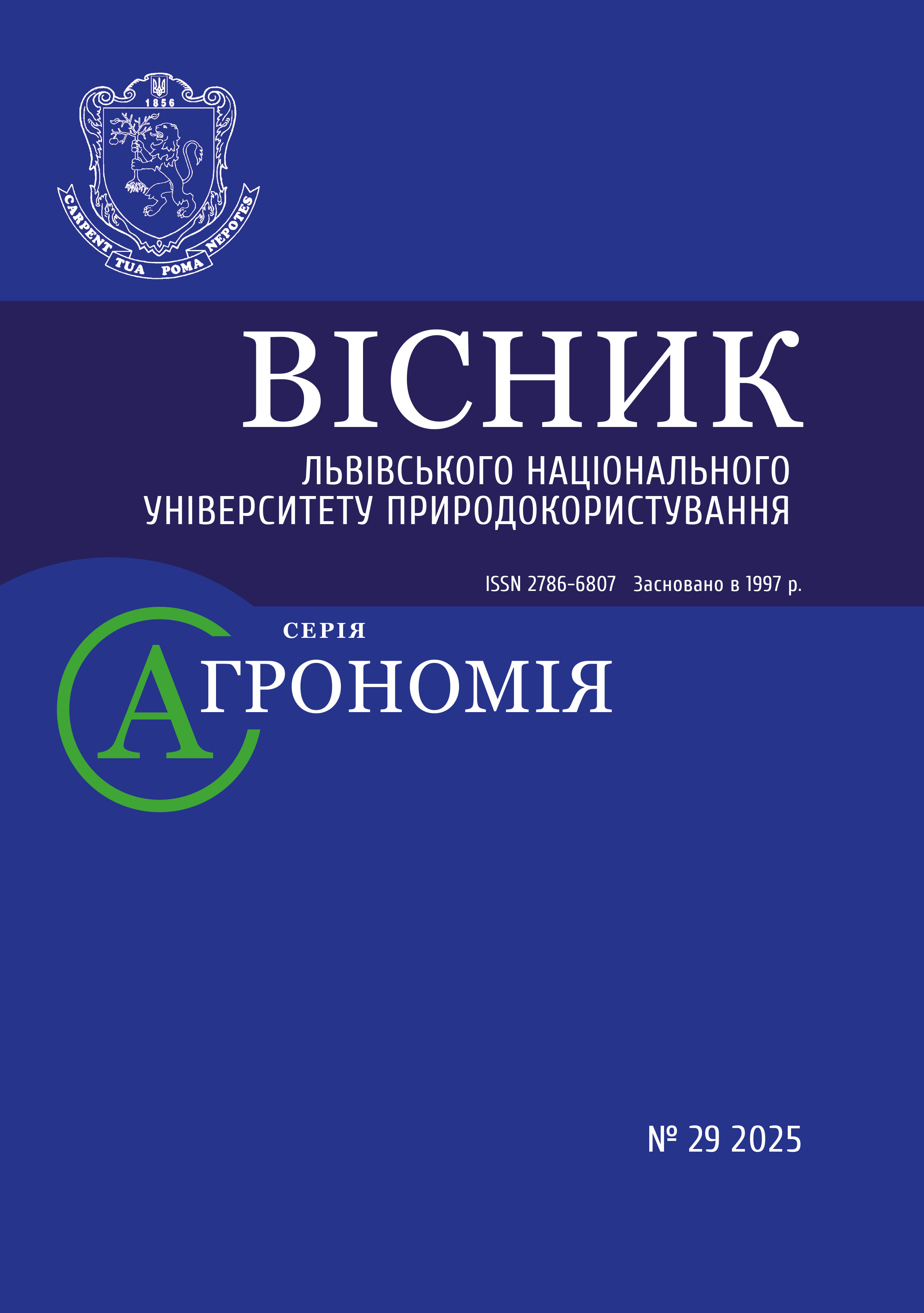PEA YIELD DEPENDING ON SOWING RATES IN THE CONDITIONS OF THE WESTERN FOREST-STEPPE OF UKRAINE
DOI:
https://doi.org/10.31734/agronomy2025.29.067Keywords:
peas, seeding rate, hydrothermal conditions, yieldAbstract
During 2022–2024, field studies were carried out at the experimental site of Lviv National Environmental University to determine the optimal sowing rate for the Salamanca pea variety under conditions of sufficient moisture in the Western Forest-Steppe region. The soil at the experimental plot is classified as dark gray podzolized, with a humus content of 2.2%. The accounting area measures 50 m², and the experiments were repeated three times. The layout of the plots was systematic, with sowing rates evaluated in the range of 0,9; 1,0; 1,1; 1,2; 1,3; 1,4 million seeds per hectare. The peas were cultivated using intensive agricultural practices, ensuring adherence to all technological components. The preceding crop for the peas was winter wheat. The fertilization regimen included Р60К60 + N60 + Mg20 + S30 + Intermag legumes (2 l/ha). Nitrogen fertilizers (ammonium nitrate, N34) were applied for straw mineralization following the wheat harvest, before disking. In the fall, triple superphosphate (Р46), potassium chloride (К60), and sulfur fertilizers (Vigor, S90) were applied during plowing. Magnesium (magnesium sulfate, S30Mg20) was introduced in the spring as part of the pre-sowing soil cultivation. Additionally, Intermag legumes microfertilizer was applied at the onset of the pea budding phase, concurrently with the fungicide Fox. Sowing occurred from April 1 to 3, with the seeding rates adhering to the experimental design and a sowing depth of 5 cm.
It was found that the highest yield (5.60 t/ha) of Salamanca variety grain on average over three years of research was formed at a seeding rate of 1.0 million/ha. It also remained high at a seeding rate of 0.9 million/ha – 5.54 t/ha. Thickening of pea crops led to a decrease in grain yield. Thus, at a seeding rate of 1.1 million/ha it was 5.48 t/ha, which is 0.12 t/ha less than the seeding rate of 1.0 million/ha. At a seeding rate of 1.2 million/ha, there was a further decrease in yield to 5.38 t/ha. Increasing the seeding rate to 1.3 million/ha resulted in a yield of 5.29 t/ha, which is 0.31 t/ha lower than the most productive option. Increasing of the seeding rate to 1.4 million/ha caused a decrease of yield to 5.15 t/ha, which is 0.45 t/ha less than the rate of 1.0 million/ha. According to the research results, the highest grain yield of peas (5.76 t/ha) was obtained in 2024. In 2023, the yield was slightly lower – 5.56 t/ha, and the lowest was in the first year of research – 4.90 t/ha. Under the influence of hydrothermal conditions of the year, the yield of peas varied in a wider range (0.86 t/ha) than under the influence of the seeding rate (0.45 t/ha).
References
Andrushko M., Lykhochvor V., Andrushko O. Tne influence of variety and rate sowing on tne yield and quality of pea grain (Pisum sativum). Tеka. Quarterly journal of agri-food industry. Rzeszow-Lviv. 2019. Vol. 19. No 4. Pp. 13–22.
Hlubokyi O. M. Improvement of elements of technology for growing pea varieties in the eastern part of the Forest-Steppe of Ukraine: dissertation of Doctor of Philosophy: 201-Agronomy / V. Ya. Yuriev Institute of Plant Growing. Kharkiv, 2023. 232 p.
Hryshchuk P. I. Influence of the density of the agrocenosis of field peas on its grain productivity. Bulletin of Uman National University of Horticulture. 2017. No 2. P. 48–51.
Lykhochvor V. V., Andrushko M. O. Influence of pea seeding rates on structural elements and grain yield. Bulletin of Poltava State Agrarian Academy. 2019. No 4. P. 51–57. https://doi.org/10.31210/visnyk2019.04.06
Lykhochvor V. V., Andrushko M. O. Pea productivity depending on the variety and seeding rate. Bulletin of Agricultural Science of the Black Sea Region: scientific journal. 2020. Issue 2. P. 54–62. Mykolaiv, 2020. https://doi.org/10.31521/2313-092X/2020-2(106)-6visnyk.mnau.edu.ua
Lykhochvor V. V., Andrushko M. O. Pea yield of the Madonna variety depending on the seeding rate. Scientific Journal of the Zhytomyr National Agroecological University. Scientific Horizons. 2019. No 12. P. 53–59. DOI: 10.33249/2663-2144-2019-85-12-53-59
Lykhochvor V. V., Prots R. R., Doliezhal Ya. Peas. Lviv: Ukrainian Technologies, 2003. 64 p.
Lykhochvor V., Andrushko M., Andrushko O. Іnfluence of variety, elements of the fertilization system, sowing rates of seeds on the pea yield (Pisum sativum). Folia pomeranae universitatis technologiae stetinensis. Folia Pomer. Univ. Technol. Stetin., Agric., Aliment., Pisc., Zootech. 2020. Wydanie 355 (54) 2. P. 23–30. DOI: 10.21005/AAPZ2020.54.2.03
Petrychenko V. F., Lykhochvor V. V. Crop production. New technologies for growing agricultural crops. 5th ed., corrected, supplemented. Lviv: Ukrainian Technologies, 2021. 806 p.
Popov S. I., Hlubokyi O. M., Avramenko S. V. Formation of productivity and grain quality of pea varieties depending on the seeding rate in the conditions of the eastern Forest-Steppe of Ukraine. Breeding and seed production. V. Ya. Yuriev. Institute of Plant Production. 2022. Issue 121. P. 94–104. https://doi.org/10.30835/2413-7510.2022.26100194-104
Rudenko V. A. Comparative productivity of wintering and spring pea varieties depending on the sowing rate in the southern Steppe of Ukraine: dissertation for the doctor of philosophy: 201-Agronomy. Odessa, 2023. 195 p.
Rybalchenko A. M., Kosenko V. Yu. The influence of pea sowing rates on the formation of structural elements and grain yield. Tavria Scientific Bulletin. 2023. No 132. P. 204–209. DOI: https://doi.org/10.32782/2226-0099.2023.132.25
Shokalo N. S., Bazhan B. O., Ozarov A. S. Formation of pea seed productivity depending on sowing rates. Bulletin of the Poltava State Agrarian Academy. 2020. No 1 (96). P. 61–66. DOI: 10.31210/visnyk2020.01.06
Weather statistics. Climatic data by years and months. Lviv region, Zhovkva district, Dubliany. URL: https://meteopost.com/weather/climate/ (Accessed January 30, 2025).


